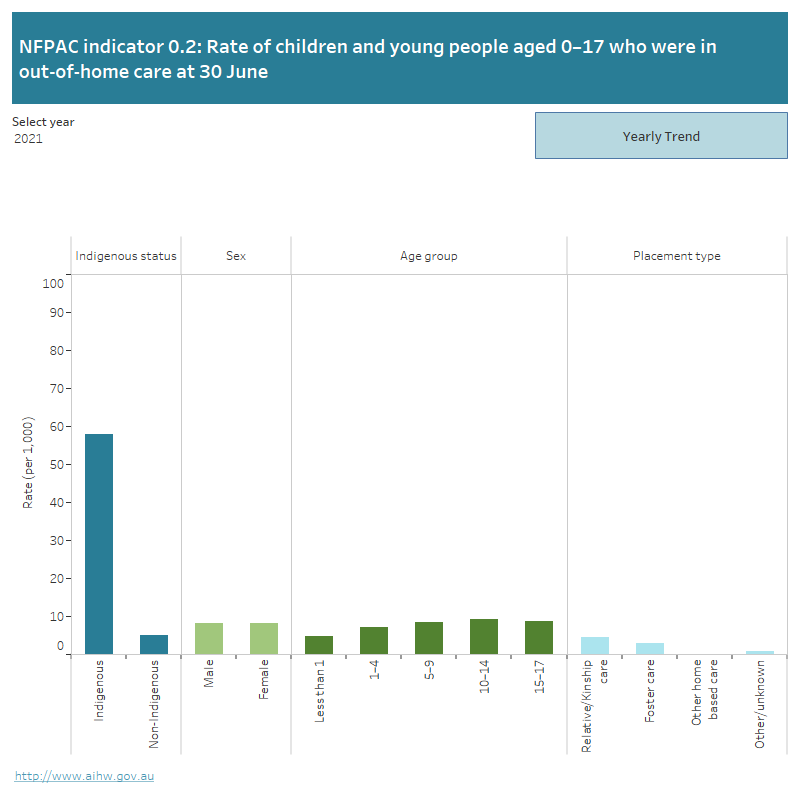0.2 Out-of-home care
Care should be taken when interpreting the time series for this indicator, as it has been affected by the implementation of the national definition of out-of-home care.
As of 2019, all states and territories have adopted a nationally consistent definition of out-of-home care which excludes children on third-party parental responsibility orders, children on immigration orders, young people aged 18 and over, and children in pre-adoptive placements from counts of children in out-of-home care.
Out-of-home care data from the 2018–19 reporting period onwards are based on this nationally agreed definition and, where possible, back cast to 2016–17. These should not be compared with data for previous years or previously published out-of-home care data.
For more information on the national definition of out-of-home care, see Child protection Australia 2018–19.
Out-of-home care is provided across Australia for children who are unable to live with their families, generally because of child abuse or neglect or because their family is unable to care for them (for example, due to illness or incarceration).
Although out-of-home care may be beneficial for children who are unsafe living with their families of origin, it is generally viewed as an intervention of last resort, and there is a preference for children to be reunited with their birth parents wherever possible.
Trend data: For all indicator displays, the yearly trend is limited to indicators with 3 or more years (including the current year) of comparable time series data. To see the trend click on “Yearly Trend” button on the display. Where 3 or more years of comparable data including the most recent year is not available, a “No time series data” message is shown on the display.
The first figure is a bar graph showing the rate of children and young people aged 0–17 who were in out-of-home care, by Indigenous status, sex, age group and placement type. Data can be displayed for select years, 2010 to 2021.
The second figure is a line graph showing the rate of children and young people aged 0–17 who were in out-of-home care at 30 June, 2017 to 2021. Data can be displayed by selected disaggregations: Indigenous status, age group, sex and placement type.

Source: AIHW Child Protection Collection
See the supplementary data tables for further information and footnotes about these data.
Indicator technical specifications
The information below provides technical specifications for the summary indicator data presented in the quick reference guide.
| Definition | Data source | |
|---|---|---|
| Numerator | Number of children aged 0–17 years who were in out-of-home care the night of 30 June | AIHW National Child Protection Data Collection |
| Denominator | Number of children aged 0–17 years at 31 March | AIHW Population Database (sourced from ABS Australian Demographic Statistics) |
Explanatory notes
Out-of-home care arrangements include overnight care for children aged 0–17, where the state makes a financial payment or where a financial payment has been offered but declined by the carer. Placement types include foster care, placements with relatives or kin, residential care, family group homes, independent living, and other funded placements not otherwise categorised. In most cases, children in out-of-home care are also on a care and protection order.
National reporting based on a consistent definition of out-of-home care was agreed in 2019; it excludes children on third-party parental responsibility orders, children on immigration orders, young people aged 18 and over, and children in pre-adoptive placements from counts of children in out-of-home care. Out-of-home care trend data in this report have been back cast to 2016–17 with the national definition for out-of-home care adopted in 2018–19. Out-of-home care data in this report should not be compared with data published prior to 2018–19 when the reporting of out-of-home care was not nationally consistent.
Only children in care on the night of 30 June are reflected in the data reported for this indicator.
Differences in legislation, policies and practices in relation to out-of-home care across jurisdictions and over time can affect the number and rate of children in out-of-home care so caution must be taken when interpreting the data.
March population estimates are usually the most recent data available for the denominator at the time the rates are calculated (i.e. June estimates are not yet available).
The COVID-19 pandemic and the resulting Australian Government closure of the international border from 20 March 2020, caused significant disruptions to the usual Australian population trends. This report uses Australian Estimated Resident Population (ERP) estimates that reflect these disruptions.
Accordingly, in the year July 2020 to June 2021, the overall population growth was much smaller than the years prior and in particular, there was a relatively large decline in the population of Victoria. ABS reporting indicates these were primarily due to net-negative international migration (National, state and territory population, June 2021 | Australian Bureau of Statistics (abs.gov.au)).
Please be aware that this change in the usual population trends may complicate interpretation of statistics calculated from these ERPs. For example, rates and proportions may be greater than in previous years due to decreases in the denominator (population size) of some sub-populations.


